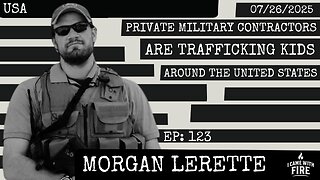Premium Only Content

It’s All in the Numbers | The Gold Standard 2342
https://www.midasgoldgroup.com/
In this episode of The Gold Standard, Ken Russo joins Jennifer Horn as they discuss ways to safeguard your finances against the ravages of the inevitable storm heading our way. They confront the stark reality of the precarious state of our financial system. The words of caution echo: “Large government deficits exist and will almost certainly increase substantially, which will require huge amounts of more debt to be sold by governments…” This dire prediction underlines the perilous over-leverage that threatens to erode the very foundation of our currency’s value.
The 2008 Financial Crisis had specific culprits, but the mid-March 2020 liquidity run revealed a broader, systemic vulnerability. Enter the Federal Reserve, stepping in to purchase treasuries at an unprecedented scale, a move often labeled “printing money.” While stabilizing interest rates, this strategy inadvertently widens the gap between Wall Street and Main Street, exposing the average citizen to future inflation risks.
The looming question is: Can this strategy continue indefinitely? With the COVID-19 pandemic persisting and interest rates near zero, the Fed’s balance sheet will swell to unparalleled proportions. Financial asset prices, particularly in equities, may surge, masking a collision course with increasing Main Street insolvencies and unemployment. Yet, easing up on printing money could lead to deflation akin to Japan in the 1990s or even rapidly escalating inflation, creating a harrowing scenario of secular stagflation. But why can the US confidently print money when other nations cannot? The key lies in the US dollar’s status as the global reserve currency, insulating it from the currency risk faced by most other countries. However, a disruptive force emerges as the world shifts towards new monetary policies, led by the central bank digital currency (CBDC) concept. This revolutionary approach fundamentally reshapes how governments manage their finances, wherein every individual and business holds an account with the central bank.
Central Bank Digital Currency or CBDC-based policy eliminates the need for issuing bonds, allowing direct spending with printed money. This paradigm shift introduces a new level of control over money, with units tagged with specific rules. CBDC will also raise a new level of government surveillance over its citizens. The emergence of CBDC-based policies in major economies like China, Japan, or the Eurozone could challenge the supremacy of the US dollar as the global reserve currency, potentially altering the financial landscape profoundly.
“We are devaluing American money so rapidly that in America today, you can’t even bribe Democrat senators with cash alone. You need to bring gold bars to get the job done.”
— Rep. Matt Gaetz, R-Florida
Florida State Representative Matt Gaetz is increasingly outspoken about the dire fiscal situation facing the United States. With the country drowning in a staggering $33 trillion of debt, equivalent to about 119 percent of the GDP, his concerns are far from unfounded. The Congressional Budget Office forecasts a federal budget deficit of $2.2 trillion for 2023, making it clear that the nation’s financial woes are only escalating. Gaetz staunchly maintains that he’s advocating a return to the fiscally conservative principles that defined the Republican party. He believes that the absolute chaos lies in a ballooning debt and an annual deficit that threatens the stability of the nation’s economy. As the value of American currency continues to plummet, Gaetz’s call for fiscal responsibility gains even more urgency, highlighting the pressing need for a robust and sustainable financial strategy.
In the wake of the Silicon Valley Bank and Signature Bank failures in March 2023, echoes of the 2008 financial crisis resound, leaving Americans questioning the stability of their banking institutions. While government officials aim to soothe concerns, recent events have undeniably sparked worry about the safety of hard-earned money. There are real concerns regarding the banking system’s financial stability. If you’re one of those who worry about a potential financial setback, you’re not alone. People with higher incomes who are acutely aware of FDIC coverage limitations. How many people still believe in the government’s ability to avert a crisis similar to the catastrophe of 2008? For many of us, the specter of a 2008-style is hard to shake. One thing is for certain, our fractional reserve banking system’s inherent instability necessitates a critical reevaluation of where we place our financial trust.
____________________________________________________________________________________________________
Listen to The Gold Standard: https://www.midasgoldgroup.com/gold-standard-radio-show/
Gold IRA: https://www.midasgoldgroup.com/gold-ira/
Invest in Gold: https://www.midasgoldgroup.com/buy-gold/
Guide to Owning Bullion & Coins: https://www.midasgoldgroup.com/bullion-guide/
Read the latest precious metals news: https://www.midasgoldgroup.com/news/
-
 25:04
25:04
Midas Gold Group
10 months agoInflation Busters | The Gold Standard 2434
50 -
 LIVE
LIVE
Jeff Ahern
1 hour agoThe Saturday Show with Jeff Ahern
11,651 watching -
 LIVE
LIVE
Film Threat
3 hours agoLIVE FROM SAN DIEGO COMIC-CON! (Saturday) | Film Threat Live
267 watching -
 31:40
31:40
Tactical Advisor
1 hour agoEveryone Talks About This AR15 Being The Best? | Vault Room Live Stream 034
44K3 -
 1:08:53
1:08:53
Michael Franzese
16 hours agoHollywood Deaths & Political Secrets: A Nation at a Crossroads?
140K84 -
 9:27
9:27
MattMorseTV
23 hours ago $13.48 earnedHe just lost EVERYTHING.
48.1K62 -
 1:40:30
1:40:30
I_Came_With_Fire_Podcast
14 hours agoPrivate Military Contractors Are TRAFFICKING KIDS Around The United States
29.5K19 -
 LIVE
LIVE
JdaDelete
15 hours ago $2.64 earnedFinal Fantasy VII Rebirth | Jdub's Journey Part 8 - Corel Prison
198 watching -
 2:39:09
2:39:09
LFA TV
20 hours agoTHE ARK ENCOUNTER LIVE EVENT! 7.26.25 9AM EST-12PM EST
207K26 -
 3:20:34
3:20:34
Sgt Wilky Plays
5 hours agoTherapeutics with Dr Kong
21.1K1